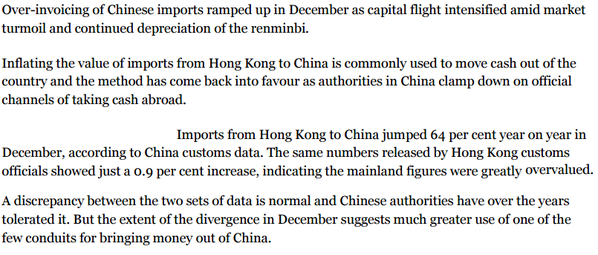Let’s begin with China, where the latest trade data shows a large discrepancy between what China supposedly imports from Hong Kong and what Hong Kong exports to China.

Source: @tracyalloway
As explained by the FT below, this is a form of capital outflow from China. With Beijing clamping down on other forms of capital withdrawals, cheating on trade invoices becomes the only viable channel by which significant amounts of capital can be moved offshore.

Source: @FT
Meanwhile, China’s stock market continues to sell off (in spite of the rally in the US on Tuesday).

On a more positive note, China’s equity market is deleveraging, as margin loan balances continue to decline.

Source: @valuewalk
The nation’s industrial profits are still falling as the economic “rebalancing” takes place. Perhaps.

Source: @stevefeiss
Related to the above, China continues to export large amounts of excess refined fuel, as domestic demand growth stalls. This is the last thing the global energy markets need now.

Source: @business
By the way, some argue that China has created a “feedback loop” with crude oil via weaker currency.

Source: @ScottFarnham
Let’s continue with the energy markets where we had the largest weekly US crude oil inventory build since last April. Oil futures fell in response.

Source: Investing.com

The market remains extremely jittery. Here is the crude oil implied volatility index over the past 5 years.

Source: Google
Moreover, crude oil bearish bets continue to increase. This is potentially becoming a rather crowded trade.

Source: @JavierBlas2, @business
As discussed before, the correlation between crude oil and equities remains elevated.

Source: @FT
We’ll have the results of our survey on the topic out tomorrow. In the meantime here is an explanation from a Daily Shot reader. A number of other responses/comments were quite similar to the one below.

Another explanation offered by Citi (via FT) is that in the current market environment correlations are extraordinarily high within the equity markets.












Leave A Comment